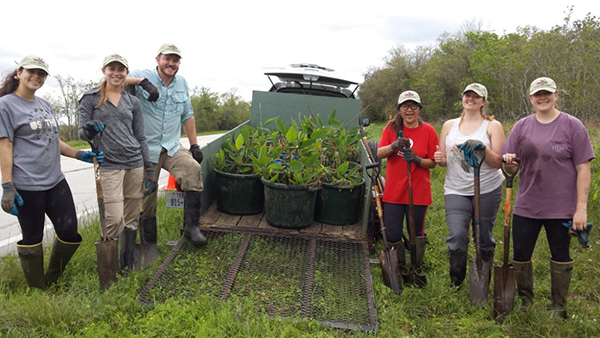Students Get Hands-On Look At Wetland Restoration In Texas Sea Grant Internship
Mar 30, 2017
Six Texas undergraduate students spent their Spring Break earlier this month learning about wetland restoration as the first participants in the Texas Sea Grant Coastal Wetland Restoration Internship Program.

During the week of March 13-17, Abigail Brown, Thuy Chau, Maryam Cheta and Lillian McAfee from Texas A&M University (TAMU) and J. Brandon Hearron and Laura Mae Hinson from Texas A&M University at Galveston (TAMUG) learned plant identification and propagation techniques at wetland plant nurseries in Clear Lake City and Lake Jackson under the guidance of Mary Carol Edwards, the Stormwater Wetland Program Coordinator at Texas Sea Grant’s Texas Coastal Watershed Program (TCWP) in Houston.
The nurseries grow freshwater plants for TCWP stormwater wetland demonstration projects, which are designed to improve water quality and habitat in the Galveston Bay watershed. The interns also visited local stormwater wetland sites to learn planting techniques for a constructed wetland and participated in hands-on wetland restoration activities at Sheldon Lake State Park with the local Texas Master Naturalists’ Wetland Restoration Team.
“There were many teachable moments where they learned why we were doing the various tasks and how they fit into the big picture of wetland restoration and stormwater wetland creation,” Edwards said.
Some of the students will continue their internship in May after the spring semester ends. The paid internship is open to undergraduate students from TAMU, TAMUG and Texas A&M University-Corpus Christi.
Hearron and Hinson, who are both seniors majoring in Ocean and Coastal Resources, gave similar reasons for applying to the program.
Hearron said he signed up for the internship to build on what he has learned in the classroom about wetland restoration, the career field he plans to pursue. He said he learned a lot during Spring Break and is looking forward to learning more when he returns in May.
This internship demonstrated the applications of groundwork in freshwater wetland conservation, restoration and mitigation,” he said. “We learned practical techniques working in nurseries and established wetlands, including plant propagation, identification and invasive species removal. We also benefited from working with and learning from several Texas Master Naturalists, all of whom brought different career experiences to supplement the wetland restoration they do.”
Hinson said her goals in pursuing the internship were two-fold.
“Primarily I see it as an opportunity to continue to gain practical field knowledge and expertise in handling the sensitive flora that is so critical to the coastal wetlands ecosystem,” she said. “It is also an opportunity to form relationships with professionals in the field of wetland sustainability in local areas. Both of these goals will serve to further my career and professional development.”
Hinson also shared why the internship was important to her.
“I acquired my passion for the outdoors from my father. He was a biologist for Texas Parks and Wildlife and worked as a Wetland Delineator for several years,” she said. “He taught me to love, respect and protect all that is wild and natural so that it remains a valued resource for generations to come. I see the Texas Sea Grant internship as an important step towards building a career where I can practice this belief in stewardship for the outdoors.”
Edwards said the interns had a great time and that they impressed her with knowledge and work ethic.
“I was honored to work with these students who opted to spend their Spring Break doing something that makes a difference to the environment of the Texas Gulf Coast. Each one of them has a lot of passion for the environment and the future, and a lot of life experience and skills already,” Edwards said. “They got to wade right in and do the kinds of things that wetland restoration biologists do in the field. Sometimes that can be pretty muddy, and yes, there are wildlife surprises!”
By: Tiffany Evans, Texas Sea Grant
###
Texas Sea Grant is a unique partnership that unites the resources of the federal government, the State of Texas and universities across the state to create knowledge, tools, products and services that benefit the economy, the environment and the citizens of Texas. It is administered through the National Oceanic and Atmospheric Administration and is one of 33 university-based Sea Grant Programs around the country. Texas Sea Grant is a non-academic research center in the College of Geosciences at Texas A&M University. The program’s mission is to improve the understanding, wise use and stewardship of Texas coastal and marine resources.

